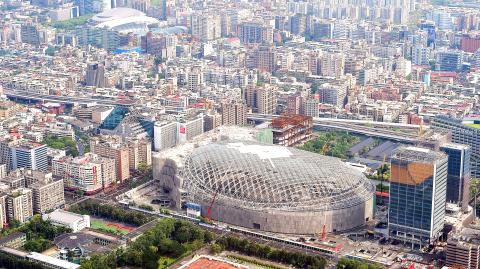The Taipei City Government last night ordered Farglory Land Development Co (遠雄建設) to halt construction of the Taipei Dome, citing concerns about “ongoing damage” to the neighboring Songshan Tobacco Factory and a “threat” to the Taipei MRT Bannan (板南) Line, which runs next to the construction site.
The announcement came less than 10 hours after Taipei Mayor Ko Wen-je (柯文哲) said he felt “the company is too arrogant” and was considering ordering the firm to cease construction until it provides a clear explanation of how it plans to guarantee safety at the site.
Ko said he was “angry” and “could not stand” Farglory’s “insincere” attitude.

Photo: Fang Pin-chao, Taipei Times
The company submitted only a single sheet of paper after being requested to provide a report on improving safety on Monday, even though abnormalities had been found on site since March.
“I feel [Farglory] is irresponsible, because it now says that construction on the foundations [of the Taipei Dome] would be drawn out until August,” Ko said.
The city government agreed to allow construction to continue when safety concerns first emerged on the grounds that the Taipei Dome would be structurally unstable until the foundations were completed.

Photo: Chien Jung-fong, Taipei Times
When asked if halting construction would be dangerous, Ko said that the firm had to provide a clear explanation of how it would address safety issues if construction was allowed to continue.
He added that the safety issues had to be addressed before any discussions took place on contractual issues.
Numerous media reports earlier yesterday said that the city government had reached a preliminary consensus with Farglory in talks on Tuesday between Farglory chairman Chao Teng-hsiung (趙藤雄) and Taipei Deputy Mayor Teng Chia-chi (鄧家基).
The reports said Farglory and the city had agreed to set up a third-party commission to investigate safety at the venue, breaking a standoff over the validity of a city-sponsored probe that called for either the Dome or its neighboring shopping mall to be demolished.
Teng denied the existence of any consensus.
“The city government absolutely did not accept Farglory’s proposals for a third-party evaluation,” he said, adding that Taipei had instead invited Farglory to submit its own plans to improve site safety.
“Without substantial content [regarding improving site safety], calling for a third-party evaluation is simply equivocating,” Teng said.
Farglory also chose to stall on construction safety issues in the hopes that the issue would blow over by the time the site’s foundations were completed, he said, adding that the issue was separate from concerns over the safety of the completed site.
As construction risks could increase with time, Farglory was responsible for giving the city a clear response on the costs and benefits of continued construction, he said.
Ko also said that Chao “reeked of alcohol” when he came in for talks, but added that he himself had not met with Chao.
In a statement, Farglory rejected Ko’s alcohol comment and called on the city to name the person who had given the mayor “mistaken information.”
The firm said the comment was a “groundless accusation” bordering on slander and “public humiliation,” and that it would take legal measures in response.

The US government has signed defense cooperation agreements with Japan and the Philippines to boost the deterrence capabilities of countries in the first island chain, a report by the National Security Bureau (NSB) showed. The main countries on the first island chain include the two nations and Taiwan. The bureau is to present the report at a meeting of the legislature’s Foreign Affairs and National Defense Committee tomorrow. The US military has deployed Typhon missile systems to Japan’s Yamaguchi Prefecture and Zambales province in the Philippines during their joint military exercises. It has also installed NMESIS anti-ship systems in Japan’s Okinawa

‘WIN-WIN’: The Philippines, and central and eastern European countries are important potential drone cooperation partners, Minister of Foreign Affairs Lin Chia-lung said Minister of Foreign Affairs Lin Chia-lung (林佳龍) in an interview published yesterday confirmed that there are joint ventures between Taiwan and Poland in the drone industry. Lin made the remark in an exclusive interview with the Chinese-language Liberty Times (the Taipei Times’ sister paper). The government-backed Taiwan Excellence Drone International Business Opportunities Alliance and the Polish Chamber of Unmanned Systems on Wednesday last week signed a memorandum of understanding in Poland to develop a “non-China” supply chain for drones and work together on key technologies. Asked if Taiwan prioritized Poland among central and eastern European countries in drone collaboration, Lin

The Chien Feng IV (勁蜂, Mighty Hornet) loitering munition is on track to enter flight tests next month in connection with potential adoption by Taiwanese and US armed forces, a government source said yesterday. The kamikaze drone, which boasts a range of 1,000km, debuted at the Taipei Aerospace and Defense Technology Exhibition in September, the official said on condition of anonymity. The Chungshan Institute of Science and Technology and US-based Kratos Defense jointly developed the platform by leveraging the engine and airframe of the latter’s MQM-178 Firejet target drone, they said. The uncrewed aerial vehicle is designed to utilize an artificial intelligence computer

Renewed border fighting between Thailand and Cambodia showed no signs of abating yesterday, leaving hundreds of thousands of displaced people in both countries living in strained conditions as more flooded into temporary shelters. Reporters on the Thai side of the border heard sounds of outgoing, indirect fire yesterday. About 400,000 people have been evacuated from affected areas in Thailand and about 700 schools closed while fighting was ongoing in four border provinces, said Thai Rear Admiral Surasant Kongsiri, a spokesman for the military. Cambodia evacuated more than 127,000 villagers and closed hundreds of schools, the Thai Ministry of Defense said. Thailand’s military announced that